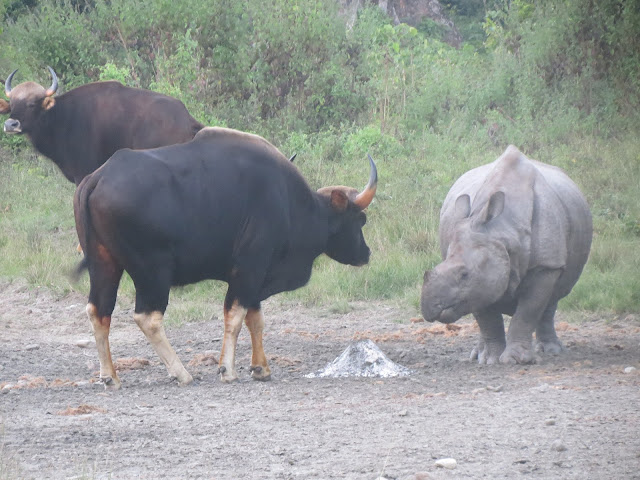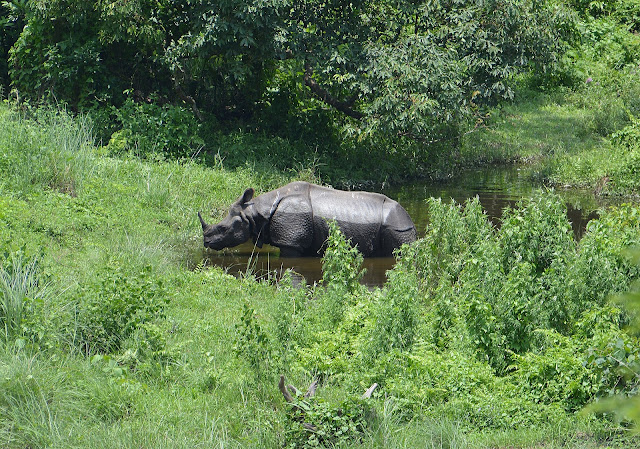 |
| One-horned rhino in Kaziranga National Park, Assam. Image credit: Anuwar ali hazarika via Wikimedia Commons. |
The one-horned rhinoceros, a magnificent species, is also called the Indian rhinoceros, and rightly so, given that India houses more than 80% of the species' current population of 4014 as of 2022. Once distributed across a larger range from the Indian subcontinent to parts of China and numbering several thousand, today, the "Vulnerable" classified one-horned rhino suffers from a multitude of threats and has disappeared from large parts of its range. In India, too, the species was on the verge of vanishing before stringent actions were implemented to save it. A lot of praise goes to the Indian state of Assam, which houses nearly 85% of the country's rhino population of around 3,300. So, here are the places where you will find the most rhinos in India as per the State of Rhino Report 2022, released by the International Rhino Foundation.
Kaziranga National Park, Assam - 2,613 rhinos
 |
| Baby Rhino with mother in a marshland of Kaziranga National Park, Assam. Image credit: RAJEEV BASUMATARY via Wikimedia Commons |
Assam's Kaziranga National Park and Tiger Reserve, also a UNESCO World Heritage Site, has performed exceptionally well in terms of one-horned rhino conservation. Poaching of these animals was rampant in this park until about a few years ago when stringent measures were taken to curb the issue. A special task force was created, and the rangers were allowed to shoot-at-sight orders to bring down poachers to save rhinos. The park now has 223 anti-poaching camps, with guards toiling hard to ensure the safety of the park's VIP rhinos! All that obviously worked well, with the park reporting zero rhino poaching in 2022.
Jaldapara National Park, West Bengal - 287 rhinos
 |
| An interesting interaction between a rhino and two Indian gaurs at Jaldapara National Park, West Bengal. Image credit: Darshana Darshu via Wikimedia Commons. |
The Jaldapara National Park recently went viral on social media as a scared and disturbed female rhino with calves in the park toppled a safari gypsy filled with tourists. Rhino moms are extremely protective of their babies and will not tolerate any nonsense from anyone that even slightly threatens their precious babies.
The park, located in the northern part of the state of West Bengal, is home to the second-highest Indian rhino population, with 287 rhinos. Recently, the state government has devised several strategies, including the expansion of the grasslands to further secure the home of the rhinos in and around the park.
Orang National Park, Assam - 125 rhinos
 |
| A rhino in the grasslands of Orang National Park. Image credit: Nejib Ahmed via Wikimedia Commons |
Another national park in Assam, the Orang, on the northern banks of the mighty Brahmaputra River, is turning out to be a secure home for the state's rhinos. No wonder that it is often called the "Little Brahmaputra." As of 2022, the park has a rhino population of 125, which is 24 up from the last count taken in 2018.
Pobitora Wildlife Sanctuary, Assam - 107
.jpeg) |
| A female rhino and calf at Pobitora Wildlife Sanctuary, Assam. |
Next up is Pobitora Wildlife Sanctuary, also from Assam, with 107 one-horned rhinos. The sanctuary is located in the suburbs of Assam's capital city, Guwahati, and is a haven for wildlife-loving residents of the city as well as numerous visitors. The 2022 number was five more than the 2018 count. The sanctuary is known to offer excellent rhino sightings to visitors and is a must-visit for those touring the state.
Gorumara National Park, West Bengal - 52
 |
| A rhino at Gorumara National Park, West Bengal. Image credit: Dr. Satyabrata Ghosh via Wikimedia Commons. |
Another protected area in northern West Bengal, the Gorumara National Park, provides a good habitat for the rhinos. Together, the Jaldapara and Gorumara host the entire population of rhinos in the state, but the state government now plans to introduce rhinos to two more protected areas, the Buxa Tiger Reserve and a small reserve in Cooch Behar.
Manas National Park, Assam - 40
 |
| A one-horned rhino at Manas National Park, Assam. Image credit: Gitartha.bordoloi via Wikimedia Commons |
Another UNESCO World Heritage Site in Assam, the extremely beautiful Manas, is home to 40 rhinos as of 2022. The park's rhinos were all wiped out by 2005 due to intense poaching, but a successful reintroduction program leading to the translocation of rhinos to the park in several batches starting in 2006 helped have a stable rhino population in Manas again.
Dudhwa National Park, Uttar Pradesh - 40
 |
| A reintroduced rhino in Dudhwa Tiger Reserve, India. Image credit: A. J. T. Johnsingh, WWF-India and NCF, via Wikimedia Commons. |
A new state's entry on the list comes with Dudhwa National Park. The beautiful park, located along the India-Nepal border in Uttar Pradesh, had lost all its rhinos due to colonial-era hunting and then poaching until rhinos were reintroduced here from Assam in 1984. Initially, five rhinos were introduced, and the population has since grown gradually.
India's efforts in saving the rhinos deserve applause. Poaching has been largely curbed in the country's rhino habitats by the strict implementation of the law. However, given the high demand for rhino horns in the illegal market, authorities need to be on constant alert to protect the rhinos against this threat. Habitat loss, degradation, fragments, and human-rhino conflict cases are now the biggest threats to this endangered species in India, and a lot of effort is needed to protect the growing population of these massive, majestic beings in the country.
No comments:
Post a Comment